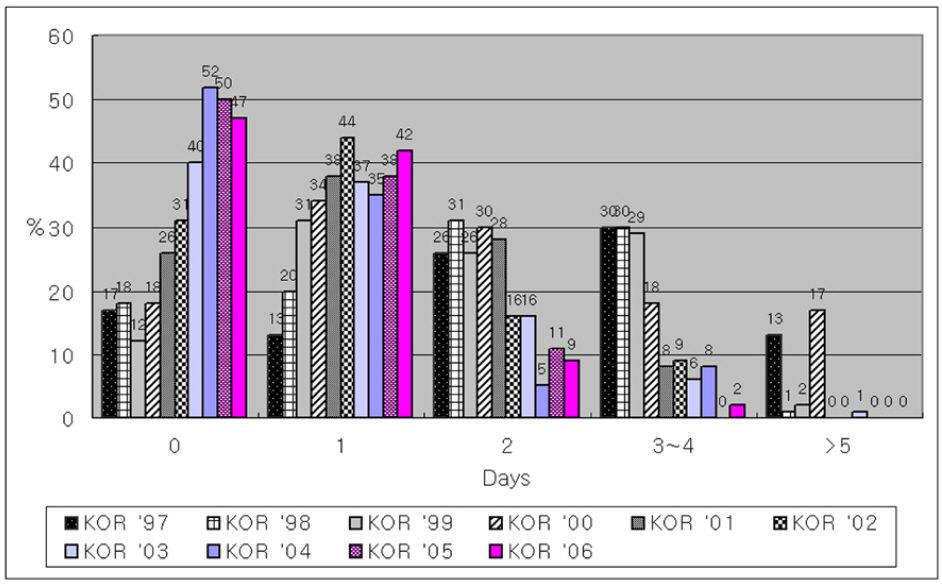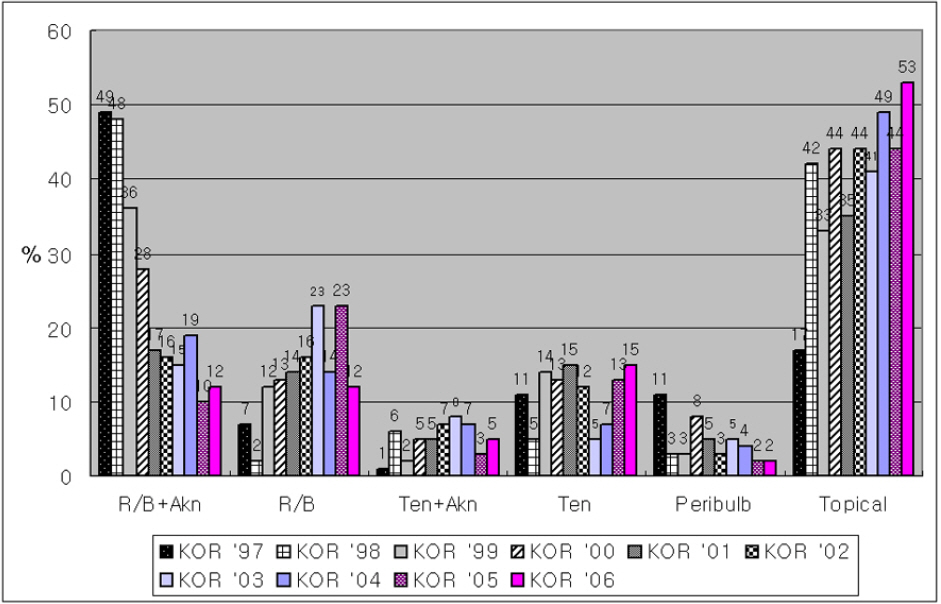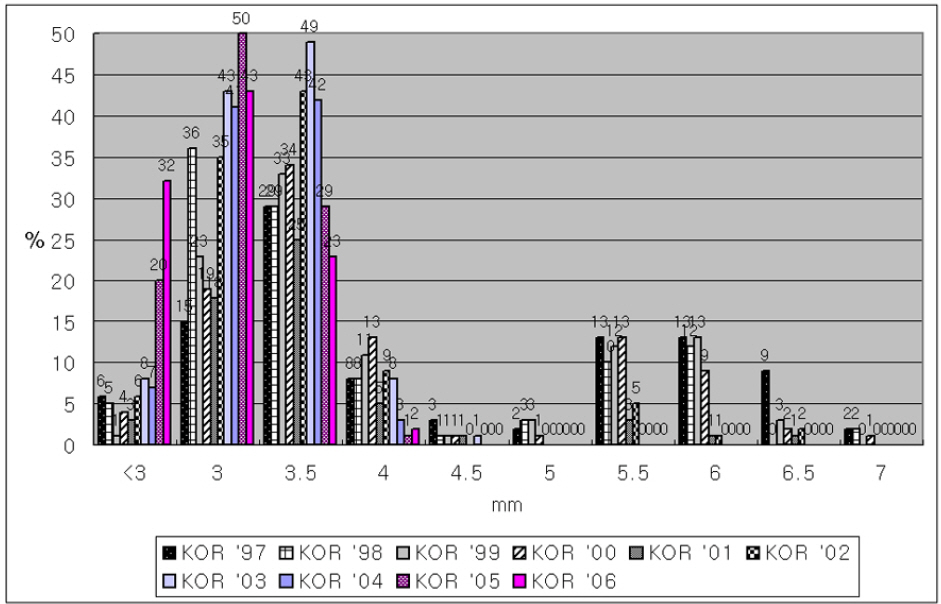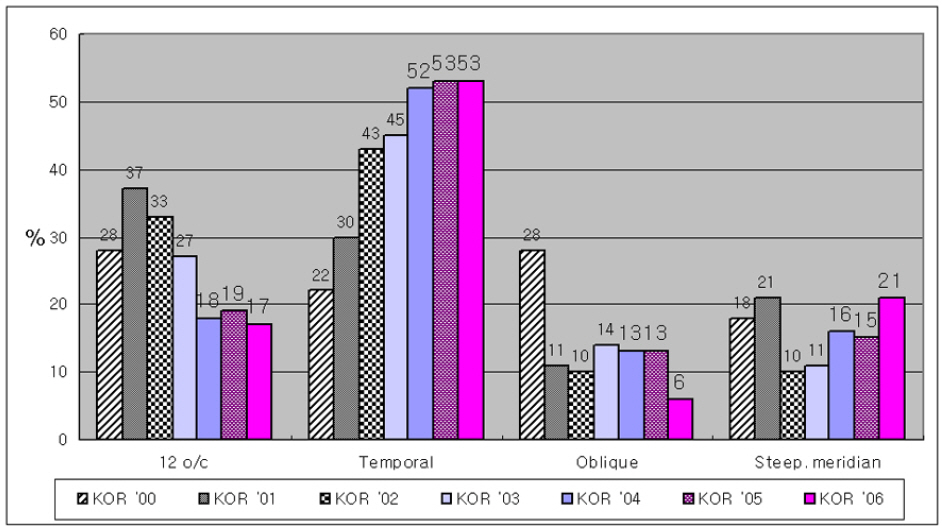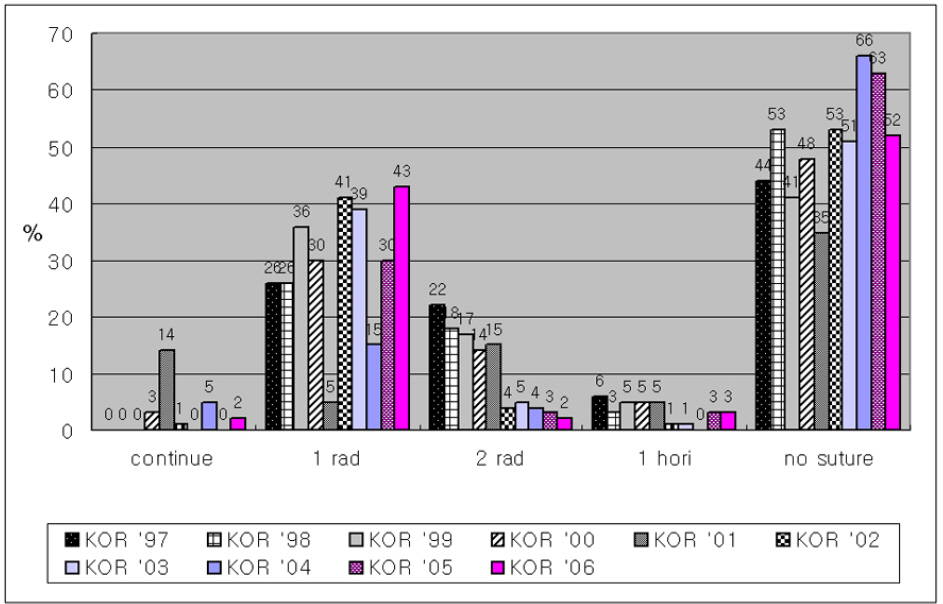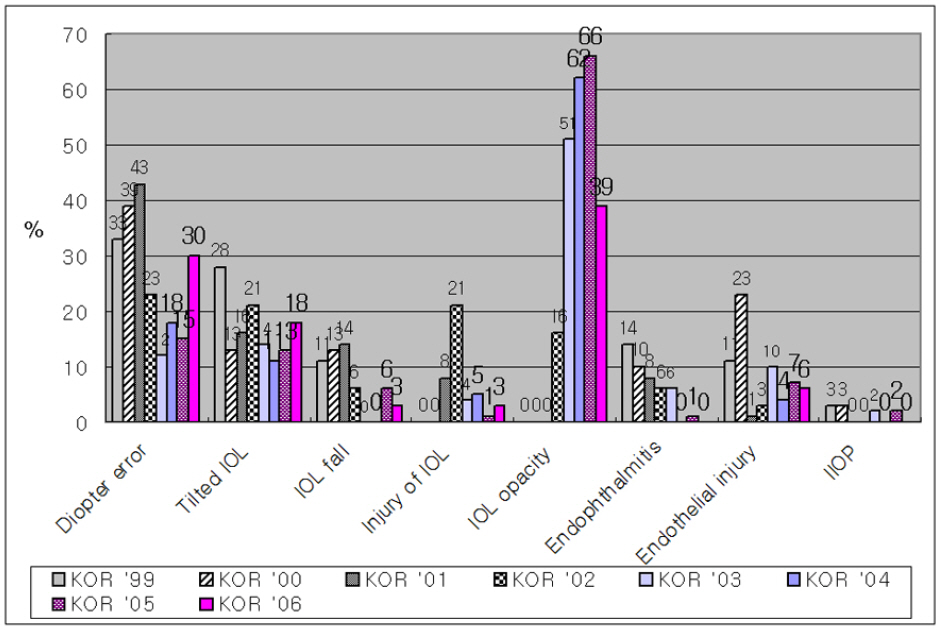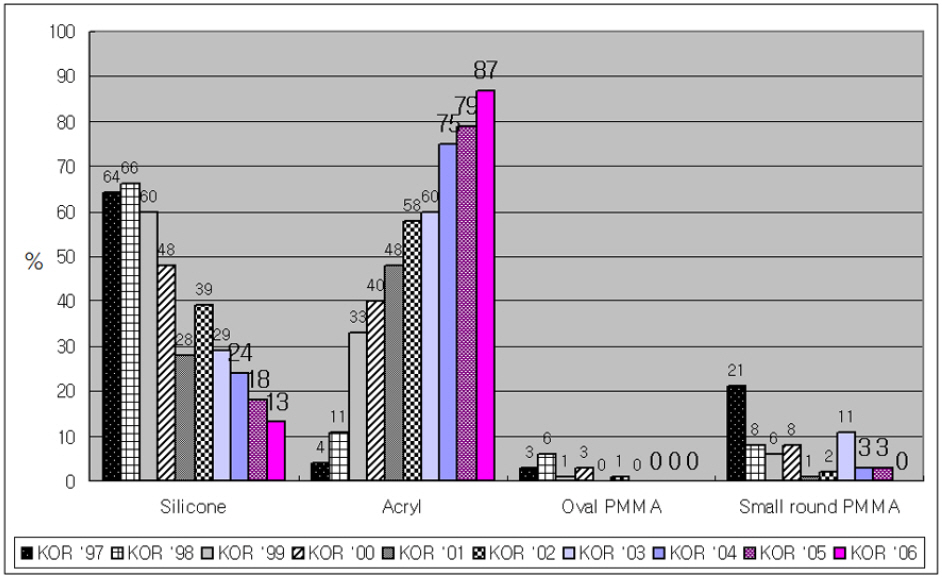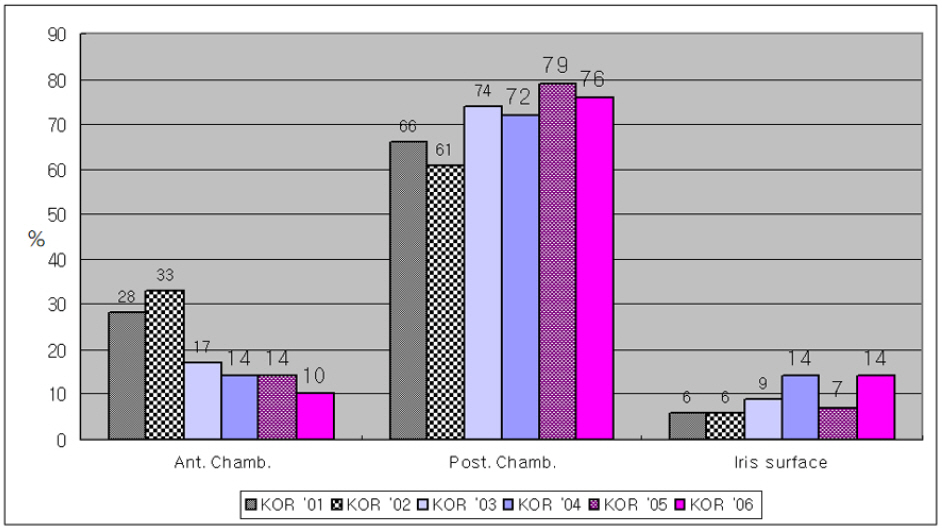J Korean Ophthalmol Soc.
2009 Nov;50(11):1617-1623.
2006 Survey for KSCRS Members: Current Trends in Cataract Surgery in Korea
- Affiliations
-
- 1Department of Ophthalmology, Gachon University Gil Medical Center, Incheon, Korea. khshyn@gilhospital.com
Abstract
- PURPOSE
To investigate the current situation and future trends in the field of cataract surgery in Korea.
METHODS
Since 1995, the members of the Korean Society of Cataract and Refractive Surgery (KSCRS) have conducted annual surveys on cataract and refractive surgery. The 2006 annual survey, consisting of 89 multiple-choice questions, was mailed in February 2007 to 289 KSCRS members. Sixty (20.7%) members answered the questions. Current data were compared with data of previous annual surveys and with data of surveys in the United States and Europe.
RESULTS
Fifty-one percent of the respondents were in their fifties. The duration of hospital stays has decreased annually, and the use of topical anesthesia (53%) has not changed. Self-sealing wound construction was the main wound closure technique in phacoemulsification (52%). The implantation of phakic intraocular lenses (IOL) was performed on 50% of the respondents, and the preferred IOLs for small incision cataract surgery were acrylic (87%). Interest in the added value of IOL has increased annually.
CONCLUSIONS
This survey summarized current trends and changes in cataract surgery in Korea.
Keyword
MeSH Terms
Figure
Reference
-
References
1. Shyn KH, Baek NH, Lee JH, et al. Current Trends in Cataract and Refractive Surgery in Korea – 1995 Survey for KSCRS Members. J Korean Ophthalmol Soc. 1998; 39:892–9.2. Shyn KH, Shim JK, Park SW. Current Trends in Cataract and Refractive Surgery in Korea – 1996 Survey for KSCRS Members. J Korean Ophthalmol Soc. 1999; 40:403–8.3. Shyn KH, Shin SH, Kim JS. Current Trends in Cataract and Refractive Surgery in Korea – 1997 Survey for KSCRS Members. J Korean Ophthalmol Soc. 1999; 40:950–8.4. Shyn KH, Park SW, Kim JS. Current Trends in Cataract and Refractive Surgery in Korea – 1998 Survey for KSCRS Members. J Korean Ophthalmol Soc. 2000; 41:1523–31.5. Shyn KH, Oh KH, Park KS. Current Trends in Cataract and Refractive Surgery in Korea – 1999 Survey for KSCRS Members. J Korean Ophthalmol Soc. 2001; 42:713–23.6. Shyn KH, Kim YS, Ha SW. Current Trends in Cataract and Refractive Surgery in Korea – 2000 Survey for KSCRS Members. J Korean Ophthalmol Soc. 2002; 43:1007–13.7. Song YS, Lee JH, Shyn KH, Kim SW. Current Trends in Cataract and Refractive Surgery in Korea – 2001 Survey for KSCRS Members. J Korean Ophthalmol Soc. 2004; 45:45–54.8. Shyn KH, Han YS, Lee JH. Current Trends in Cataract and Refractive Surgery in Korea – 2002 Survey for KSCRS Members. J Korean Ophthalmol Soc. 2004; 45:55–63.9. Shyn KH, Bae JY, Moon HS. Current Trends in Cataract and Refractive Surgery in Korea – 2003 Survey for KSCRS Members. J Korean Ophthalmol Soc. 2005; 46:35–44.10. Shyn KH, Chi MJ, Sohn HJ. Current Trends in Cataract and Refractive Surgery in Korea – 2004 Survey for KSCRS Members. J Korean Ophthalmol Soc. 2006; 47:214–20.11. Lee DY, Roh JH, Shyn KH. Current Trends in Cataract Surgery in Korea – 2005 Survey for KSCRS Members. J Korean Ophthalmol Soc. 2007; 48:485–92.12. Leaming DV. Practice styles and preferences of ASCRS members – 1985 survey. J Cataract Refract Surg. 1986; 12:380–4.13. Leaming DV. Practice styles and preferences of ASCRS members – 1986 survey. J Cataract Refract Surg. 1987; 13:561–7.14. Leaming DV. Practice styles and preferences of ASCRS members – 1987 survey. J Cataract Refract Surg. 1988; 14:552–9.
Article15. Leaming DV. Practice styles and preferences of ASCRS members – 1988 survey. J Cataract Refract Surg. 1989; 15:689–97.
Article16. Leaming DV. Practice styles and preferences of ASCRS members – 1989 survey. J Cataract Refract Surg. 1990; 16:624–32.17. Leaming DV. Practice styles and preferences of ASCRS members – 1990 survey. J Cataract Refract Surg. 1991; 17:495–502.18. Leaming DV. Practice styles and preferences of ASCRS members-1991 survey. J Cataract Refract Surg. 1992; 18:460–9.19. Leaming DV. Practice styles and preferences of ASCRS members – 1992 survey. J Cataract Refract Surg. 1993; 19:600–6.20. Leaming DV. Practice styles and preferences of ASCRS members – 1993 survey. J Cataract Refract Surg. 1994; 20:495–67.21. Leaming DV. Practice styles and preferences of ASCRS members – 1994 survey. J Cataract Refract Surg. 1995; 21:378–85.22. Leaming DV. Practice styles and preferences of ASCRS members – 1995 survey. J Cataract Refract Surg. 1996; 22:931–9.23. Leaming DV. Practice styles and preferences of ASCRS members – 1996 survey. J Cataract Refract Surg. 1997; 23:527–35.24. Leaming DV. Practice styles and preferences of ASCRS members – 1997 survey. J Cataract Refract Surg. 1998; 24:552–61.25. Leaming DV. Practice styles and preferences of ASCRS members – 1998 survey. J Cataract Refract Surg. 1999; 25:851–9.26. Leaming DV. Practice styles and preferences of ASCRS members – 1999 survey. J Cataract Refract Surg. 2000; 26:913–21.27. Leaming DV. Practice styles and preferences of ASCRS members – 2000 survey. J Cataract Refract Surg. 2001; 27:948–55.28. Leaming DV. Practice styles and preferences of ASCRS members – 2001 survey. J Cataract Refract Surg. 2002; 28:1681–8.29. Leaming DV. Practice styles and preferences of ASCRS members – 2002 survey. J Cataract Refract Surg. 2003; 29:495–67.30. Leaming DV. Practice styles and preferences of ASCRS members – 2003 survey. J Cataract Refract Surg. 2004; 30:892–900.31. Leaming DV. Guest editorial – Snapshots. J Cataract Refract Surg. 2006; 32:1401–2.32. Oshika T, Masuda K, Majima Y, et al. Current trends in cataract and refractive surgery in Japan:1992 survey. Jpn J Ophthalmol. 1993; 7:432–44.33. Oshika T, Masuda K, Hayashi F, et al. 1993 Survey of the Japanese Society of Cataract and Refractive Surgery Members. Intraocular Lens and Refractive Surgery. 1994; 8:130–55.34. Oshika T, Masuda K, Majima Y, et al. Current trends in cataract and refractive surgery in Japan: 1994 survey. Jpn J Ophthalmol. 1995; 39:265–73.35. Oshika T, Masuda K, Majima Y, et al. Current trends in cataract and refractive surgery in Japan: 1995 survey. Jpn J Ophthalmol. 1996; 40:419–33.36. Oshika T, Ariae M, Masuda K, et al. Current trends in cataract and refractive surgery in Japan: 1996 survey. Jpn J Ophthalmol. 1998; 42:227–41.
Article37. Oshika T, Ariae M, Masuda K, et al. Current trends in cataract and refractive surgery in Japan: 1997 survey. Jpn J Ophthalmol. 1999; 43:139–47.
Article38. Oshika T, Ariae M, Masuda K, et al. Current trends in cataract and refractive surgery in Japan: 1998 survey. Jpn J Ophthalmol. 2000; 44:268–76.
Article39. Oshika T, Ariae M, Masuda K, et al. Current trends in cataract and refractive surgery in Japan: 1999 survey. Jpn J Ophthalmol. 2001; 43:383–7.
Article40. Macky TA, Werner L, Soliman MM, et al. Opacification of two hydrophilic acrylic intraocular lenses 3 months after implantation. Ophthalmic Surg Lasers Imaging. 2003; 34:197–202.
Article
- Full Text Links
- Actions
-
Cited
- CITED
-
- Close
- Share
- Similar articles
-
- 2006 Survey for KSCRS Members: Current Trends in Refractive Surgery in Korea
- 2004 Survey for KSCRS Members: Current Trends in Cataract Surgery in Korea
- 2007 Survey for KSCRS Members: Current Trends in Refractive Surgery in Korea
- 2005 Survey for KSCRS Members: Current Trends in Cataract Surgery in Korea
- 2003 Survey for KSCRS Members: Current Trends in Cataract and Refractive Surgery in Korea

